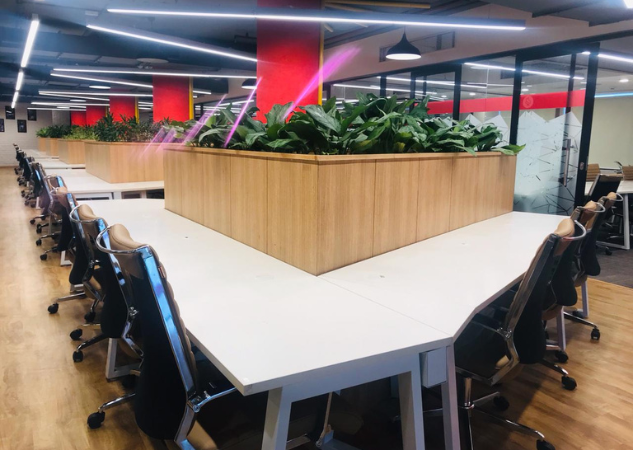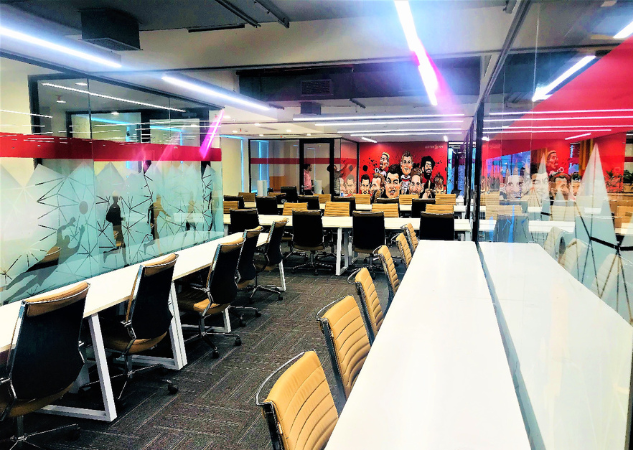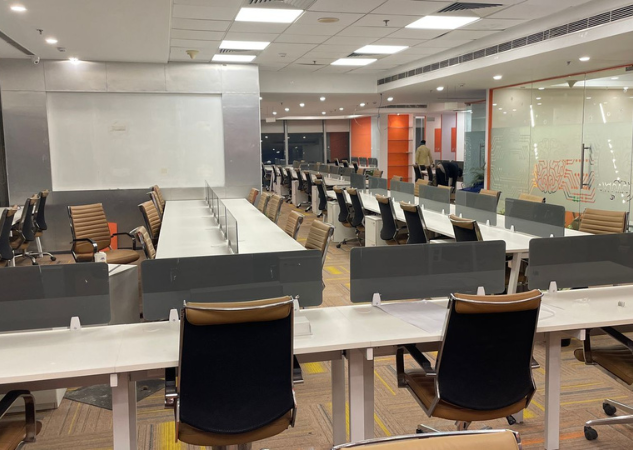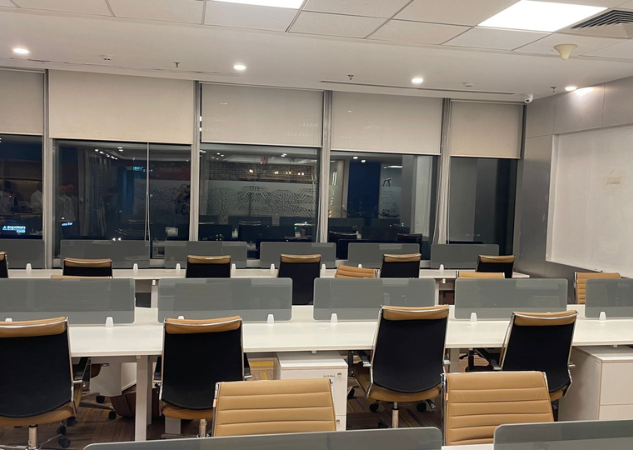Coworking spaces are thriving in 2025, and smart tech is key to managing them. From booking systems to management software, here are 10 must-have tools.
💡 Are you looking for Coworking space in Gurgaon, Noida or Delhi? We are just a call away. Call Now: 08999 828282
Top 10 Technologies for Coworking Spaces in 2025
- Advanced Coworking Management Software
- AI-Powered Coworking Space Management Tools
- Smart Access Control Systems
- IoT-Powered Smart Office Solutions
- Flexible Workspace Management Software
- High-Speed Internet & 5G Connectivity
- Virtual & Augmented Reality (VR & AR)
- Coworking Scheduling Software for Bookings
- Automated Billing & Payment Solutions
- AI Chatbots for 24/7 Support
1. Advanced Coworking Management Software
The backbone of any coworking space is its coworking management software. This all-in-one tool allows operators to manage everything from member registration and invoicing to meeting room bookings and access control.
Top platforms like Nexudus, OfficeRnD, and Cobot offer:
- User dashboards for members
- CRM and analytics tools
- Automated billing and invoices
- Integration with calendars and payment systems

2. AI-Powered Coworking Space Management Tools
AI is revolutionizing how coworking space management tools work. These tools can analyze space usage, monitor trends, and suggest improvements.
For example:
AI predicts which desks or rooms are most popular.
- It can recommend layouts to reduce overcrowding.
- AI helps optimize air quality and lighting based on real-time data.
By using AI, operators reduce waste and improve the experience for every member.
3. Smart Access Control Systems
Forget old-school keys. Today’s coworking spaces use:
- Mobile app-based entry
- RFID-enabled cards
- Facial recognition and biometric access
This tech improves security and flexibility, letting members access the space 24/7 while keeping unauthorized people out. Systems like Salto KS and Kisi integrate smoothly with most coworking space management software.
Also Read: How Does A Coworking Space Work?
4. IoT-Powered Smart Office Solutions
IoT (Internet of Things) connects devices in the space to make them smarter. These systems can automatically:
- Adjust lighting based on natural daylight
- Monitor room occupancy in real time
- Control HVAC systems to reduce energy waste
Smart solutions like Envoy and VergeSense offer a data-driven approach to shared office space management software.
5. Flexible Workspace Management Software
In the era of hybrid work, flexibility is king. Flexible workspace management software allows users to:
- Book desks or rooms from anywhere
- See real-time availability
- Schedule recurring meetings
- Support both hot desking and fixed desks
Platforms like Skedda and Robin make this possible, offering clean user interfaces and integration with tools like Google Workspace or Microsoft Teams.
6. High-Speed Internet & 5G Connectivity
A must-have for any coworking space is reliable, high-speed internet. With 5G connectivity, members benefit from:
- Faster uploads/downloads
- Seamless video conferencing
- Smooth operation of cloud-based tools
This not only improves member satisfaction but also supports remote work, digital collaboration, and streaming.
7. Virtual & Augmented Reality (VR & AR)
While still emerging, VR and AR are becoming more common in premium coworking spaces. These technologies offer:
- Virtual office tours for new members
- AR-guided onboarding experiences
- Immersive collaboration with remote teams
Tools like Spatial and Horizon Workrooms are helping coworking spaces reach global audiences and support digital nomads.
8. Coworking Scheduling Software for Bookings
Managing room and desk reservations manually is time-consuming and error-prone. That’s where coworking scheduling software comes in.
With apps like Kadence and Deskbird, you can:
- Automate desk bookings
- Send reminders for upcoming meetings
- Prevent double-booking or no-shows
This improves usage efficiency and enhances the member experience.
💡 Are you looking for Coworking space in Gurgaon, Noida or Delhi? We are just a call away. Call Now: 08999 828282
9. Automated Billing & Payment Solutions
Gone are the days of chasing invoices. The best coworking management software includes payment integrations with:
- Stripe
- PayPal
- GoCardless
Members can pay automatically every month, get receipts, and manage plans on their own—saving operators tons of admin time.
10. AI Chatbots for 24/7 Support
AI-powered chatbots offer quick answers and support at any time of day. These smart assistants can:
- Greet new members
- Answer FAQs
- Guide users through booking or payments
They integrate easily into your website or member portal, reducing the need for full-time front-desk staff while still offering great service.
The Future is Smart and Automated
Technology is redefining coworking spaces in 2025, making them smarter, safer, and more efficient than ever. From AI-powered access to seamless connectivity and energy-efficient systems, the right tech boosts productivity and user experience. If you’re looking to work in a space that keeps up with the future, make the smart move today. The Office Pass (TOP) offers tech-enabled coworking spaces across India designed for modern businesses. Contact us today at 89998 28282 for inquiries, workspace bookings, or to schedule a visit.
FREQUENTLY ASKED QUESTIONS (FAQS):
Question: What is coworking management software?
Answer: Coworking management software is a tool that helps manage operations within a coworking space, such as member registrations, payments, room bookings, invoicing, and communication. It helps streamline daily tasks for operators and provides a smooth experience for members.
Question: What are the best coworking management software options available in 2025?
Answer: Some of the top coworking management software options include:
- Nexudus
- OfficeRnD
- Cobot
- The Office App
These platforms help with scheduling, member management, billing, and much more.
Question: How does AI improve coworking space management?
Answer: AI helps optimize the management of coworking spaces by:
- Analyzing space usage patterns
- Predicting peak hours and desk demand
- Automating tasks like booking and invoicing
- Improving energy management through IoT sensors
- AI-driven coworking space management tools help create smarter, more efficient environments.
Question: What are the benefits of using flexible workspace management software?
Answer: Flexible workspace management software allows operators to manage flexible desk bookings, room reservations, and member schedules. This software is ideal for hybrid work environments where employees need the option to work from any location within the coworking space.
Question: What is the role of IoT in coworking spaces?
Answer: IoT (Internet of Things) connects devices to optimize the environment in coworking spaces. It can:
- Adjust lighting and temperature based on occupancy
- Monitor desk usage in real-time
- Reduce energy consumption
This creates a more comfortable and sustainable space for members.
Question: How can coworking scheduling software improve productivity?
Answer: Coworking scheduling software helps members easily book desks, meeting rooms, or other shared resources. It ensures that spaces are used efficiently and that double-bookings are prevented, allowing for better time management and productivity.
Question: How can AI chatbots enhance the customer experience in coworking spaces?
Answer: AI chatbots provide 24/7 support to members by answering common questions, assisting with bookings, providing information about membership plans, and guiding users through the registration process. This increases customer satisfaction and reduces the need for manual intervention.
Question: What are the security benefits of smart access control in coworking spaces?
Answer: Smart access control systems provide secure, keyless entry through mobile apps, RFID cards, or biometrics like facial recognition. This enhances security by restricting access to authorized users and allowing real-time monitoring of who enters and exits the space.
Question: Why is high-speed internet important in coworking spaces?
Answer: High-speed internet is essential in coworking spaces to ensure smooth and reliable connectivity for members. With increasing use of video conferencing, cloud services, and remote collaboration, fast and reliable internet allows users to work efficiently without technical issues.
Question: What are the future trends for technology in coworking spaces?
Answer: In the coming years, coworking spaces are expected to embrace:
- More AI-driven automation for space management
- Advanced VR/AR for remote collaboration
- 5G connectivity for faster, more reliable internet
- Sustainability-focused tech like energy-efficient IoT solutions
These technologies will make coworking spaces even smarter, more flexible, and more user-friendly.









